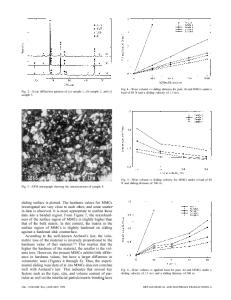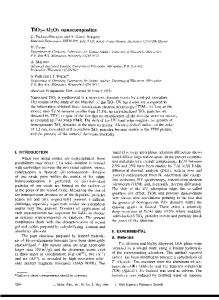Gamma-Titanium Aluminide Reinforced with Al 2 O 3 and TiB 2 Fibers
- PDF / 2,230,694 Bytes
- 6 Pages / 420.48 x 639 pts Page_size
- 2 Downloads / 353 Views
GAMMA-TITANIUM ALUMINIDE REINFORCED WITH A12 03 AND TiB2 FIBERS* DARRELL DIXON** AND JOSEPH W. NEWKIRKt Air Force Base, TN 37389-3400 tUniversity of Missouri-Rolla, Metallurgical Engineering Department, Rolla, MO 65401
"**TheBionetics Corporation, Arnold
ABSTRACT A two-phase Ti-47A1-2Ta composite reinforced with a titanium diboride (TiB 2 ) and two alumina fibers was processed by hot isotatic pressing and heat treated to simulate service conditions.Diffusion couples were heat treated between 5930C and 9820C for up to 500 h and analyzed using a scanning electron microscope and energy dispersive x-ray spectroscopy. The fibers used were 3M® alumina, Sapphikon® sapphire, and Textron Specialty Materials TiB 2. Observations reveal reaction layers, cracking fibers due to thermal stress, and chemical interactions between ternary addition of Ta with the fibers. Alumina is thermodynamically stable in TiAl, and its coefficient of thermal expansion closely matches TiAl. Observations revealing alumina as a good potential reinforcement in TiAl are discussed. Thermodynamic information supports TiB 2 stability in two-phase TiAI. A three-fold increase of Ta at the fiber/ matrix interface of TiB 2 is evidence of a lack of homogeneity due to Ta mobility. This indicates a possible loss of oxidation resistance provided by the Ta addition. INTRODUCTION Gamma-titanium aluminide is one of several materials possessing a combination of high-temperature strength and low weight. Because of these properties, it has excellent potential as a high-temperature material to replace current aerospace materials; however, it has low room-temperature ductility which must be managed by engineering solutions. Two solutions to reduce the low-ductility problem include ternary alloy additions and composite reinforcements. Ternary additions include V, Cr, or Mn.1 Increased ductility or other properties, such as oxidation resistance, dependent upon well-distributed alloying additions may be lost if the microstructure or alloying element distribution does not remain homogeneous. In this investigation, tantalum was added primarily for oxidation resistance (personal communication with C. Sabinash, McDonnell-Douglas Corporation, 1991). Besides chemical means to improve ductility, composite fiber reinforcements have been used to toughen materials, but interfacial integrity is important. Fiber dissolution, brittle reaction layers, and interfacial void formation are~among the many causes of poor composite performance. ?his paper will examine the performance and reaction layers of three fibers and the interaction of tantalum with three fibers. These fibers are 3M® alumina, Sapphikon® sapphire, and Textron Specialty Materials titanium diboride (TiB 2 ) fibers, impregnated into a two-phase Ti-47A1-2Ta (atomic percent) matrix. Diffusion couples were heat treatedand analyzed by scanning electron microscope (SEM) and energy dispersive x-ray spectroscopy (EDS) techniques.
"Work and analysis for this research were done by personnel of the University of Missouri-Rolls. Met
Data Loading...











